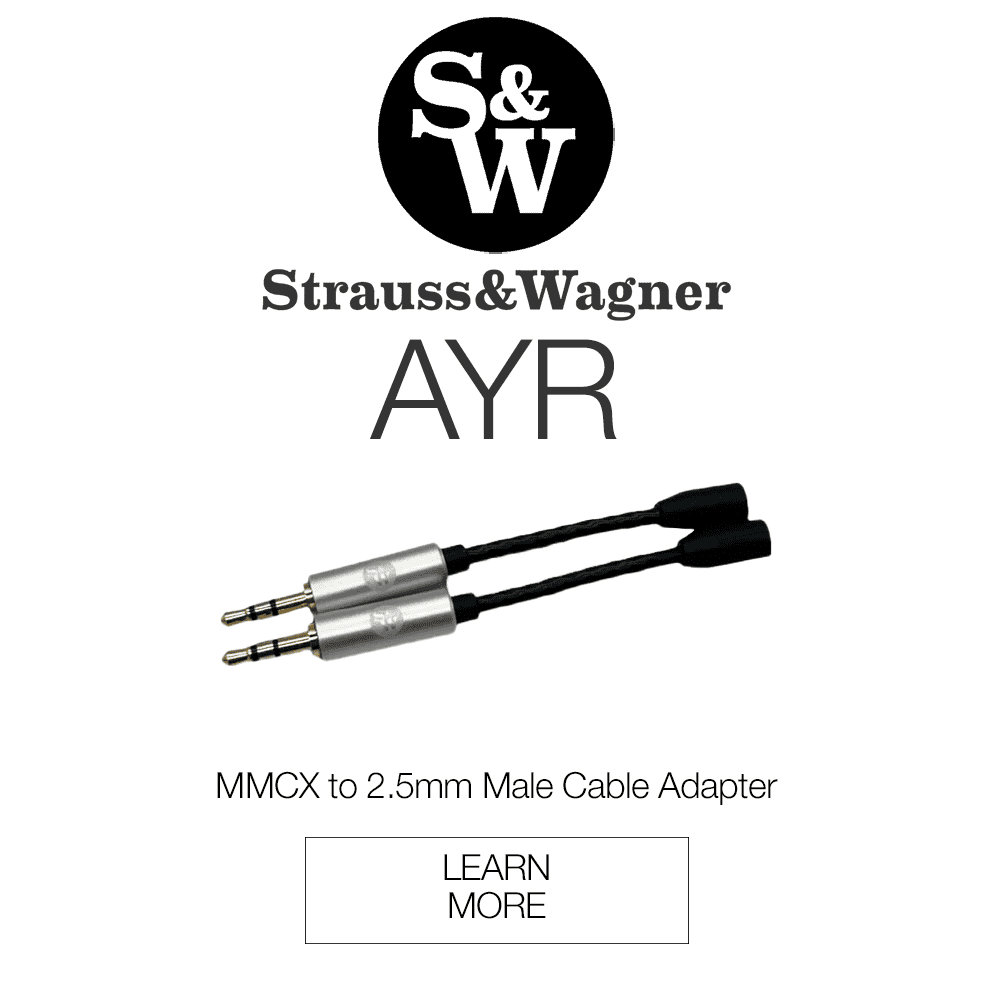The Audioquest Dragonfly Red has been a staple in the audiophile community as one of the most portable DAC/amps out there. However, with the newest release of the Dragonfly Cobalt, we were curious if it was worth the upgrade from the Red. With $100 difference in their price, does the sound really improve that much? Let’s take a closer look with this Audioquest Dragonfly Comparison: Cobalt vs Red! Comparison Review.
Audioquest Comparison: Dragonfly Cobalt vs Dragonfly Red Comparison Review
In the Box
| Audioquest Dragonfly Cobalt | Audioquest Dragonfly Red |
|---|---|
| Dragonfly Cobalt DAC/amp | Dragonfly Red DAC/amp |
| Leather protective case | Leather protective case |
| Dragon Tail USB C | Documentation |
| Documentation |
Design
Look and Feel

I had never considered the Dragonfly Series a DAC that needed to decrease its footprint. However, the Audioquest Dragonfly Cobalt did just that. It has a rounder, shorter, slightly thinner shape than the Dragonfly Red. As a result, it seems to have a more modern, sleek look. While the Red has an old-school, flash-drive look, the attention to detail in the ridges of the Cobalt gives it a more modern feel.
Both the Dragonfly Cobalt and the Dragonfly Red have a strong feeling of durability with their (what feels like) aluminum housings and glossy finish of blue and red respectively. Additionally, both have USB covers to protect them when not in use.
Features and Upgrades
To answer the question of whether or not the Audioquest Dragonfly Cobalt is worth upgrading from the Dragonfly Red, it is worth examining the following improvements. And just in case you can’t handle the anticipation, yes! It is worth upgrading.
DAC Chip
While all three Audioquest Dragonfly DACs use ESS Sabre chips, the Dragonfly Cobalt has an upgraded chip from the Red. The Dragonfly Red has an ESS ES9016 chip. This chip features a minimum phase fast roll-off filter. Roll-off filters in DACs are used to remove quantization noise. A fast roll-off means that the curve of the roll-off has a steep slope. As a result, it is more dramatic, but sounds less natural. By comparison, the Dragonfly Cobalt has an ESS ES9038Q2M chip. This chip uses the same minimum phase method, but has a slow roll-off filter. In other words, the slope of its cut-off is smoother, thus giving it a more natural, expressive sound according to Audioquest.
Power Supply Filtering
By nature, Bluetooth, WIFI, and cell signals are noisy. As a result, listening this way introduces small, inaudible noise into the signal which can limit our perception of dynamic range, soundstage, low frequency pitch, and emotional impact in the music. Audioquest’s research and development for the Dragonfly Cobalt proved special power supply filtering solves these issues, and thus, has a big leg up in emotional impact compared to the Dragonfly Red which doesn’t utilize this tool.
Microcontroller/Microprocessor
Both the Audioquest Dragonfly Red and Black use the same chip for their microcontroller and microprocessor: the PIC32MX270. By contrast, the Dragonfly Cobalt features the PICMX274 chip, which reduces the amount of current it draws from the phone or computer, and increases its processing speed by 33%. And like the Red and Black, the Cobalt is firmware upgradeable because of this chip.
Includes Dragontail USBC – USB A to USB C Adapter
Lastly, the Audioquest Dragonfly Cobalt includes the Dragontail USB A To USB C adapter. This adapter has minimal jitter and noise, and thus helps to preserve details over other USB-A to USB-C Adapters. Additionally, it reduces potential RF interference with its carbon-based noise dissipation system. It has a $22 value, and thus makes the difference between the Cobalt and Dragonfly Red $78 verses $100.
Specifications
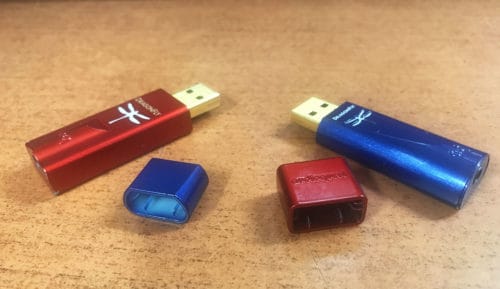
| Audioquest Dragonfly Cobalt | Audioquest Dragonfly Red | |
|---|---|---|
| Supported Sample Rates | 44.1 kHz, 48 kHz, 88.2 kHz, 96 kHz, MQA | 44.1 kHz, 48 kHz, 88.2 kHz, 96 kHz, MQA |
| Output | 2.1 V | 2.1 V |
| Headphone Amplifier | ESS Sabre 9601 | ESS Sabre 9601 |
| Microcontroller/Microprocessor | PIC32MX274 (33% increase processing speed) | PIX32MX270 |
| DAC Chip | ESS ES9038W2M (minimum phase slow roll-off) | ESS ES 9016 (minimum phase fast roll-off) |
| Volume Control | 64 bit perfect | 64 bit perfect |
Sound
Low Frequencies
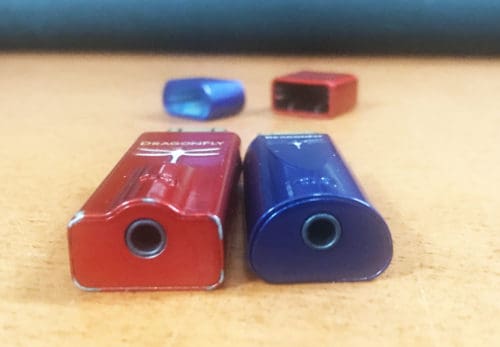
The low frequencies of the Audioquest Dragonfly Cobalt and Red have a similar feeling of punchiness, but differ in their sense of tightness, spaciousness and pitch accuracy. The Cobalt’s cleaner noise floor provides more space around low frequency rich instruments. As a result, instruments with low frequency overtones sound more realistic, with more specificity to their pitches. On the other hand, the Dragonfly Red certainly has a nice feeling of punch to it. However, it feels a little bit less three dimensional in the low end.
For example, when I was listening to the song Normal by Conor Oberst and the Mystic Valley Band, the kick drum sounded tighter and more precise when I was listening with the Dragonfly Cobalt over the Dragonfly Red. I heard more precision in its sustain, and thus it seemed to have more spaciousness around it. Additionally, I heard greater separation between the bass guitar and the kick drum with the Cobalt than the Red.
Middle Frequencies

The middle frequencies of the Audioquest Dragonfly Cobalt seemed to have a slightly different weighting than the Dragonfly Red. The Dragonfly Red had a greater deal of emphasis on the high-mids. Vocals, strings, horns, and the snaps of drums felt more forward in space. On the other hand, the Dragonfly Cobalt felt more natural and even, with a sense of warmth while maintaining detail and separation.
For example, when I was listening to the song Shout Mountain Music by Old Crow Medicine Show, the fiddles, vocals, attacks on the acoustic guitar had more emphasis and felt closer in space with the Red. And while they had a lot of detail, they had a less aesthetically pleasing tonality than they did with the Cobalt. On the other hand, the Cobalt helped them sit back in space, giving them a greater sense of naturalness. They had a greater sense of warmth, but retained their separation from each other and from the upright bass below them.
High Frequencies
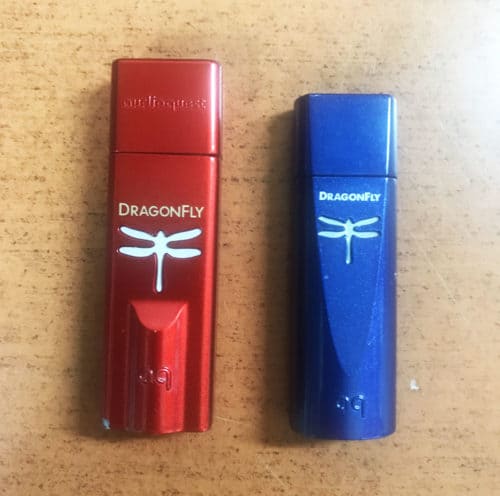
The high frequencies of the Audioquest Dragonfly Cobalt and Dragonfly Red have detail and harmonic complexity. However, the Dragonfly Cobalt had a greater sense of spaciousness around the highs. As a result, cymbals, hand percussion, the overtones of strings and vocal breath had what felt like a greater sense of extension and movement. While the Dragonfly Red did a great job of translating the details of the highs, it didn’t have the same kind of expressive quality that the Cobalt had. However, interestingly, because the highs are slightly more condensed into less space with the Red, they feel slightly louder in the mix.
For example, when I was listening to the song Fever by Ray Charles featuring Natalie Cole, the finger snaps and cymbals sounded a little bit louder in the mix with the Audioquest Dragonfly Red than with the Dragonfly Cobalt. However, they felt more lively and extended with the Cobalt. Additionally, the cymbal flares seemed to have a greater sense of expressiveness with the Cobalt.
Soundstage
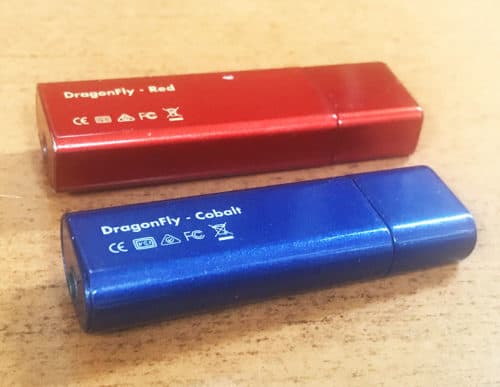
The soundstages of the Audioquest Dragonfly Cobalt and Dragonfly Red differ due to their differences in noise floor and frequency response weightings. On one hand, the Dragonfly Cobalt has spaciousness across the frequency spectrum, and thus produces a greater feeling of extension in all three dimensions. The sense of height feels more extended in the highs, and more accurately placed in the lows. Additionally, the sense of width has a greater specificity to it because of the separation around midrange and high frequency instruments. The feeling of depth benefited from this separation as well. On the other hand, the Dragonfly feels slightly more condensed. Due to its high-mid emphasis, instruments with high-mid information lean forward in space. It has a nice sense of depth, but doesn’t have the same level of separation among midrange and high frequency instruments as the Cobalt, making it less precise feeling. Similarly, it doesn’t feel quite as extended in the highs. It has a similar reach in the lows, but ultimately feels less tall.
For example, when I was listening to the song 1919 by Terri Lyne Carrington, the cymbals felt taller in space with the Dragonfly Cobalt than with the Red. Additionally, the splayed width of the piano in the stereo field felt more precise with the Cobalt. I could certainly hear the difference in space of the different keys, but they had less space around them with the Red. As a result, the piano had a greater sense of emotional impact. Additionally, the upright bass and drums felt like they were in a similar place backward in space as the drums with the Red. On the other hand, with the Cobalt, the drums felt further back, putting greater and more accurate separation between the piano, upright bass, and drums.
Overview
Overall, the Audioquest Dragonfly Cobalt and Dragonfly Red are astoundingly portable, and enhance the sound off of your phone or computer. In their price points, both offer grip and clarity. However, when listening side-by-side, it is undeniable that the Cobalt has a clearer, more precise, more emotionally impactful, and more aesthetically pleasing sound than the Red. If you have the money to upgrade, it will certainly be worth the extra $100 and then some!
The Audioquest Dragonfly Cobalt and Dragonfly Red are available for the best price here
For an alternative to Audioquest, check our review of the iFi hip-dac.
MajorHiFi may receive commission through retail offers.
Compare the ranking of various headphones, earbuds and in-ear monitors using our tools.
Discuss this, and much more, over on our forum.
---MAJORHIFI may receive commissions from retail offers.






